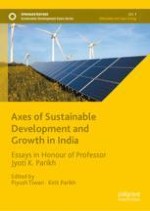2023 | OriginalPaper | Chapter
3. Projection of Water Demand in India in a Macroeconomic Consistency Framework Incorporating the Food, Water and Energy Nexus
Author : Probal Pratap Ghosh
Published in: Axes of Sustainable Development and Growth in India
Publisher: Springer Nature Singapore
Activate our intelligent search to find suitable subject content or patents.
Select sections of text to find matching patents with Artificial Intelligence. powered by
Select sections of text to find additional relevant content using AI-assisted search. powered by
